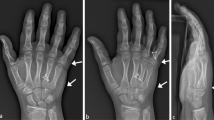Abstract
Literature review and anecdotal evidence appears to suggest a variation in the number of imaging projections used to demonstrate recent injury to the wrist, dependent on which Accident and Emergency (A&E) radiology department a patient attends. Some departments routinely undertake two projections (dorsi-palmar and lateral) whilst others include a dorsi-palmar oblique projection. The aim of this research was to assess if the inclusion of the additional projection altered the sensitivity of bony injury detection. Four readers reported 250 anonymous image sets, initially of two projections, and then at a later date, reported the same two projections along with the additional third projection, however, they did not have access to their previous reports. The readers identified 4.4% more fractures with the additional projection. Additionally, 2.8% of the fractures had not been identified by any reader on two projections, but were identified by all readers with three projections. Statistical analysis using chi-square test identified a statistical difference in the bone injury detection sensitivity (p < 0.001) when including a third projection. Kappa statistics assessed inter-observer correlation which increased from 0.68 on two projections to 0.78 on three projections. The number of equivocal reports reduced to less than half when the third projection was included. There is an increase in the sensitivity of bone injury identification with the additional projection, which is likely to be of significance to patients and A&E departments, with obviously beneficial social and financial implications.



Similar content being viewed by others
References
Brealey S, Scuffham A (2005) The effect of introducing radiographer reporting on the availability of reports for Accident and Emergency and General Practitioner examinations: a time-series analysis. Br J Radiol 78:538–542 Available from: http://www.bjr.org
Angermann P, Lohmann M (1993) Injuries to the hand and wrist. A study of 50,272 injuries. J Hand Surg Br [serial on the Internet] 18B:642–644
McAldinden P, Teh J (2003) Imaging of the wrist. Imaging 15:180–192
Richards B, Riego de Dios R, Craig W (last updated 2006) Radius, Distal Fractures. [serial on the Internet] available from: http://www.emedicine.com
Dandy D, Edwards D (1998) Essential orthopaedics and truama, 3rd edn. Churchill Livingstone, London, p 207
Raby N, Berman L, de Lacey G (2005) Accident and emergency radiology a survival guide, 2nd edn. Elsevier Saunders, London, pp 108–129
Jayasekera N, Akhtar N, Compson J (2005) Physical examination of the carpal bones by orthopaedic and accident and emergency surgeons. J Hand Surg Br [serial on the Internet] 30B2:204–206 Available from http://www.jhs.sagepub.com
Guly H (1992) Diagnostic errors in trauma care and how to avoid them. Clinical Press Limited, Bristol, p 111
Royal College of Radiologists (2007) Making the best use of a Department of Clinical Radiography. Guidelines for Doctors 6th edn. London, Royal College of Radiologists
American College of Radiology (2005) American College of Radiology ACR Appropriateness Criteria. Reviewed [serial on the Internet] available from: http://www.acr.org
National Radiological Protection Board (2001) X-rays: how safe are they? London, NRPB
Department of Health (2000) The Ionising Radiation (Medical Exposure) Regulations 2000, Statutory Instrument 1059. HMSO, London, UK
Chakravarty D, Sloan J, Brenchley J (2002) Risk reduction through skeletal scintigraphy as a screening tool in suspected scaphoid fracture: a literature review. Emerg Med J [serial on the Internet] 19:507–509 Available from: http://www.emj.bmj.com
Dandy D, Edwards D (1998) Essential orthopaedics and trauma, 3rd edn. Churchill Livingston, London, pp 221–224
De Smet A, Doherty M, Norris M, Hollister M, Smith D (1999) Are oblique views needed for trauma radiography of the distal extremities? Am J Roentgenol 172:1561–156 Available from: http://www.ajronline.org
Russin L, Berman G, Miller L, Griffin W, Walter M, Bhargavan M, Sunshine J (2003) Should the routine wrist examination for trauma be a four-view study, including a semisupinated oblique view? American Journal of Roentgenology [serial on the Internet] Available from: http://www.ajronline.org
Harris M, and Taylor G. Medical Statistics Made Easy. London:Martin Dunitz 67-68
Piper K, Paterson A, Godfrey R (2005) Accuracy of radiographers’ reports in the interpretation of radiographic examinations of the skeletal system: a review of 6796 cases. Radiography 11:27–34
Brealey S, King D, Hahn S, Crow M, Williams P, Rutter P, Crane S (2005) Radiographers and radiologists reporting plain radiograph requests from accident and emergency and general practice. Clin Radiol 60:710–717 [serial on the Internet] Available from: http://www.elsevier.com
Author information
Authors and Affiliations
Corresponding author
Rights and permissions
About this article
Cite this article
Jackson, M.E., Henderson, J.E. Following trauma, should adult wrist radiographic examinations be two or three projections?. Emerg Radiol 17, 87–93 (2010). https://doi.org/10.1007/s10140-009-0836-4
Received:
Accepted:
Published:
Issue Date:
DOI: https://doi.org/10.1007/s10140-009-0836-4




